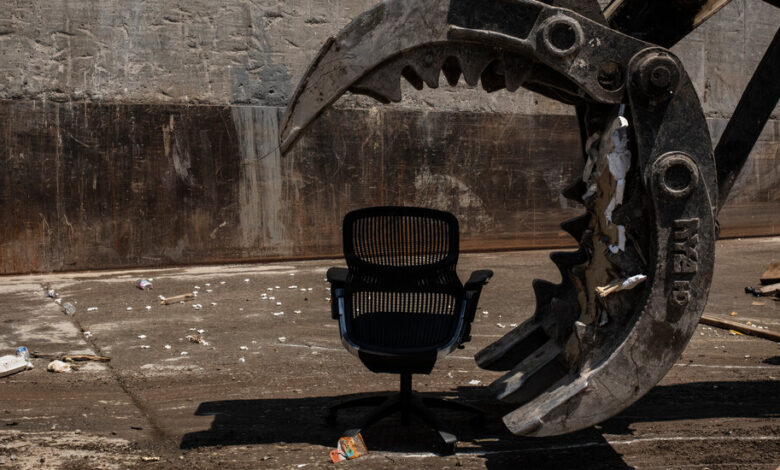Where Does New York City Office Furniture Go When No One Wants It?

[ad_1]
Herman Miller is one of the most revered makers of office furniture in the world, its designs so esteemed that its Aeron chair, which became a fixture of New York City cubicles, was put in the Museum of Modern Art’s permanent collection.
This month, some Herman Miller chairs, which can retail for over $1,000, met a less dignified fate: an appointment with the crushing metal jaws of an excavator.
More than three years after the coronavirus pandemic began, about half of the office space in the New York City metro area in June was occupied, according to Kastle Systems, a security-card company tracking activity in office buildings. The hollowing out of the city’s cubicles has raised existential economic and cultural questions, but also a big logistical one: What do you do with all that office furniture?
The answer can often be found in the back of a moving truck — en route to the auction block, a liquidator or, more likely, a landfill. Some of the furniture has found new purpose in schools, churches and movers’ living rooms; other pieces have been repackaged by hip resellers, or shipped across the globe.
Over 70 million square feet of direct office space was available for lease in Manhattan in the second quarter of 2023, a record high, compared with about 40 million square feet before the pandemic began, according to Savills, a large commercial real estate brokerage that tracks the market. New leasing also remains far below pre-Covid levels.
A small class of movers and liquidators has been thrust into the suddenly growing office-afterlife market. Lior Rachmany, the chief executive of Dumbo Moving and Storage, said a rush of businesses put their furnishings into the company’s storage facilities in 2021 and 2022. Close to 2,000 midsize companies in the region, from law firms to tech start-ups, have stored office equipment in Dumbo’s three New Jersey warehouses since Covid hit.
We have “never seen so many Herman Miller chairs,” he said.
The shift in the wait-and-see posture has translated this year into a growing number of clients failing to pay for storage, Mr. Rachmany said; the company now holds auctions for delinquent lots five times a year, up from once or twice a year before the pandemic. It also regularly donates unclaimed items to local charities, he said, but a lot of that inventory still gets discarded, because of a lack of warehouse space.
At a Dumbo company warehouse recently in East Orange, N.J., on an industrial stretch opposite a cemetery, a crew of workers was preparing to jettison the last of a 9,500-pound office lot that a Brooklyn tech company had had in storage since April 2021. According to Mr. Rachmany, the client paid for the disposal of, among other things: 25 Herman Miller chairs; 20 computer monitor stands; 10 cubicle panels; nine boxes of carpet; and two flat-screen TVs.
“The amount of waste in this industry would boggle your mind,” said David Esterlit, the owner of OHR Home Office Solutions, a refurbishing company and liquidator in Midtown Manhattan that has resold equipment from big office tenants.
The Dumbo crew drove for over an hour to the Maspeth neighborhood of Queens, arriving at a waste transfer station — one of 38 in New York City — where towering excavators were crushing all manner of commercial debris, and the air smelled like acetone. The trash’s final destination could be a landfill in upstate New York or Pennsylvania, a station manager said.
The van backed onto a giant industrial scale to weigh its cargo: 1,080 pounds, at a cost of $81 to Dumbo. Two workers in lime green shirts tossed one chair after another near a mountain of chewed-up debris that was sorted roughly into recyclable metal and everything else.
Despite efforts to reuse and repurpose office equipment, most still ends up in the trash, said Trevor Langdon, the chief executive of Green Standards, a sustainability consulting company that helps to minimize office waste. Based on 2018 federal statistics on waste, the latest year with available data, Mr. Langdon estimates that more than 10 million tons of office furniture in the United States end up in a landfill every year.
Green Standards said it has diverted almost 39,000 tons of office waste from landfills since the pandemic began.
The Brooklyn office equipment was not so lucky. In a choppy motion, the mouth of the excavator swung over the half-ton pile of furniture and chomped down, contorting the chairs into a dangly metal cephalopod.
Then a worker removed a final chair from the van and placed it gently on the asphalt. Its ergonomic back rest caught the wind to perform one last spin. Then, the excavator crunched down, and the chair exploded into a hail of plastic bits.
Susan C. Beachy contributed research.
[ad_2]
Source link






